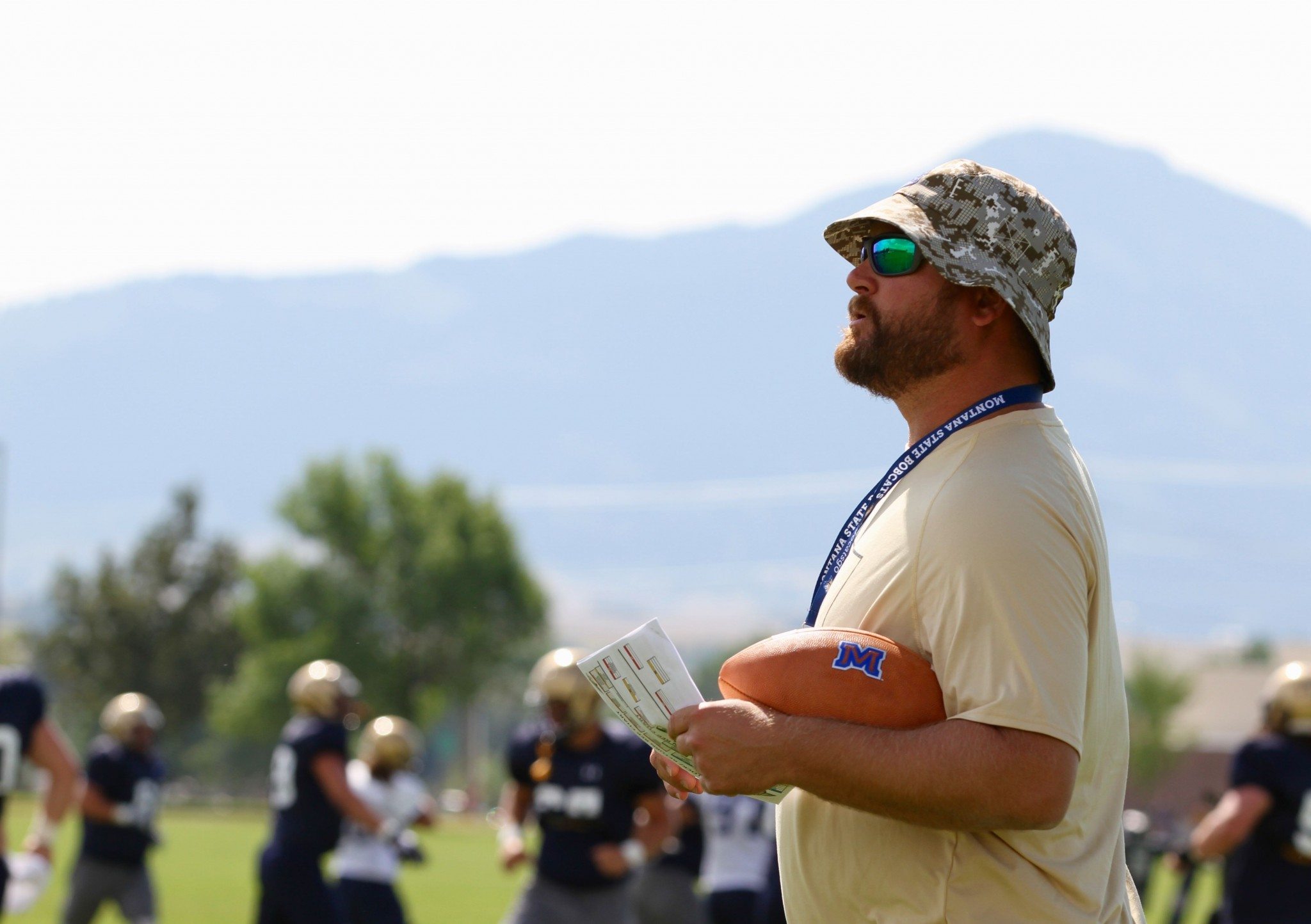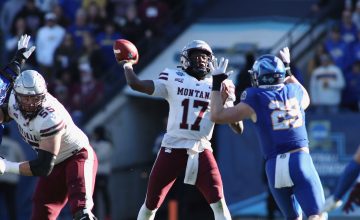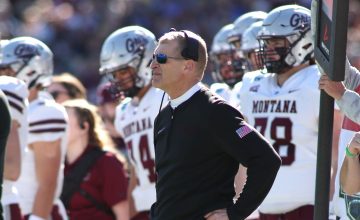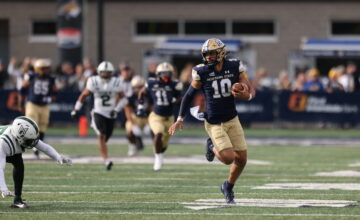Ty Gregorak put on his headset in an uncustomary place on Saturday afternoon. When he started talking to Jeff Choate from his unfamiliar seat in the Bobcat Stadium press box, nobody was home.
“We had a little bit of a phone issue,” Gregorak said in jest following Monday morning’s helmets-only practice at Dyche Field on the Montana State campus. “I get up in the box and I’m like, ‘Hello, hello? Can anyone hear me? Scrimmage is starting. Is anyone there?’”
Chalk it up as another adjustment as Gregorak establishes himself in what used to be enemy territory.
For 12 of the last 13 seasons, Gregorak has been impossible to miss during fall Saturdays in Missoula. The imposing 6-foot-4 giant who started at middle linebacker for Colorado as a freshman in the late 1990s has stalked the Washington-Grizzly Stadium sidelines for more than a decade, first as Bobby Hauck’s linebackers coach, then as the defensive coordinator under Mick Delaney for three seasons and last season under Bob Stitt. Even in his years as the Grizzlies’ play-caller, Gregorak stood on the sidelines, coaching his players with as much vigor and exasperation as any coach in the league.
A split with Stitt coupled with a new opportunity from Choate led to the bombshell of the off-season. Gregorak joined Choate’s first staff at Montana State to coordinator Bobcat defense looking to redefine its identity. It remains to be seen whether the press box is Gregorak’s new permanent home on Saturdays.
“I almost threw my fist through the window once, I almost jumped through the window twice,” Gregorak joked of his first press box experience as a Bobcat. “No, but it’s good that you can see a lot up there.
“With the dynamic of the staff, we have a young, passionate, energetic defensive line coach (Byron Hout) who I think needs to be on the field with his guys. (Linebackers coach) Kane will handle signals. Coach Ioane has his linebackers. And the secondary coach (Gerald Alexander) is vital to me to be down on the field during game day. Just the way that the makeup of our staff is, I have the smallest group (Buck ends). I have one position; the other guys have multiple positions. I think with the makeup of the staff and who we are as individuals and coaches, the best thing is for me to go up.”
Montana State opens its season on September 1 against Idaho.
Gregorak’s defenses in Missoula produced a string of standout players and performances. He helped Jordan Tripp and Caleb McSurdy earn All-America status. Each ended up getting drafted into the NFL. Gregorak helped mold John Kanongata’a, Shawn Lebsock, Loren Utterback, Shane McIntyre and Brent Meyers into first-team All-Big Sky players. Gregorak helped mentor Brock Coyle into an NFL talent; the Bozeman product still plays for the Seattle Seahawks. Playing in his defensive scheme, defensive end Zack Wagenmann earned 2014 Big Sky Defensive MVP honors and defensive end Tyrone Holmes was the 2015 FCS Defensive Player of the Year.
“Love him, love his intensity, his philosophy, love everything about him,” said MSU senior Fletcher Collins, the front-runner to start at middle linebacker. “He really harps on us about the small things. That’s what we need to focus on right now as a defense.”
Gregorak takes over a defensive unit that struggled mightily for the last two and a half seasons, whether it was not forcing a punt in a 54-29 loss at Eastern Washington that sparked a three-game losing streak to end 2013 or giving up touchdowns on eight consecutive possessions in a 59-42 loss at Portland State last season. The Bobcats have revamped their scheme and returned to basics, emphasizing toughness, energy and fundamentals over the first nine days of fall camp.
“He brings a lot of fire and a lot of intensity,” MSU junior outside linebacker Blake Braun said last week. “He’s not satisfied with anything. He’s always ready to get better. If someone makes a great play, good job, move on to the next one because that’s what you have to do in the game of football. That didn’t happen last year.”
While Gregorak is in the midst of changing colors within one of the fiercest rivalries in college football, new offensive coordinator Courtney Messingham is adjusting to coaching in the FCS for the first time in more than a decade.
The veteran was a four-year letterman at FCS Northern Iowa before beginning his coaching career at NAIA St. Ambrose in 1991. He made stops at Lakes Community College and Division II Truman State before earning his first Division I offensive coordinator position at Missouri State in 1999.
In 2003, Messingham earned his first head coaching job at Upper Iowa and by 2005, he was in the FBS. He made stops coaching various offensive positions at Southern Miss (2005-2008) and Iowa State before earning the Cyclones’ OC job for the 2012 and 2013 seasons. The last two seasons, Messingham has worked for Kevin Wilson at Indiana as an offensive quality control director.
“Football is football,” Messingham said. “Years ago, a guy I worked for at an NAIA school (Ray Jauch) who had been a head coach in the CFL, a head coach in the USFL and he told me, ‘you will have just as much joy when they score a touchdown if there’s 10 people out there watching or if there is 100,000.’ When those kids make plays and it comes together for them, it’s rewarding to see and you love them the same no matter if there’s a bunch of people watching or not very many.”
For the last two years, Montana State has scored points and ate up yards in proliferation. But the result has not translated into the win column as much as one might assume. Despite averaging 42 points per game last season, Montana State went 5-6. Against Big Sky Conference teams, Montana State scored at least 35 points in eight of nine games (MSU played Eastern Washington in the non-conference) and won just three of those games. Montana State has scored at least 40 points 11 times over the last two seasons and the Bobcats are 6-5 in those games.
“I tell our guys and I really believe this: stats are for losers,” Choate said last week. “I think stats are something you look at and say, ‘We didn’t win but we put up all these yards and points.’ I just don’t focus on that. There’s really only one stat that matters and that’s what the scoreboard says at the end of the game.”
Messingham has used the first dozen practices of fall camp to install his diverse offense featuring zone-read option elements, power run elements, play-action passes, a predication on taking care of the football and an emphasis on controlling the clock. He agrees with Choate’s assessment when it comes to the post-game stat sheet.
“I’m going on my 27th year and I’ve been a coordinator or a head coach for 14 of those years and the bottom line is if we don’t end up celebrating a victory at the end of the day, all those stats don’t mean a whole lot,” Messingham said. “The fans are coming to see us be successful, do things right and give ourselves a chance to win every week. Not to go have a track meet.”
Montana State will not practice Tuesday, marking MSU’s first day off of Choate’s first fall camp. Montana State practices twice Wednesday and once Thursday leading up to Friday’s 6 p.m. scrimmage in Bobcat Stadium. That session is free and open to the public.
Photos by Brooks Nuanez. All Rights Reserved.


















